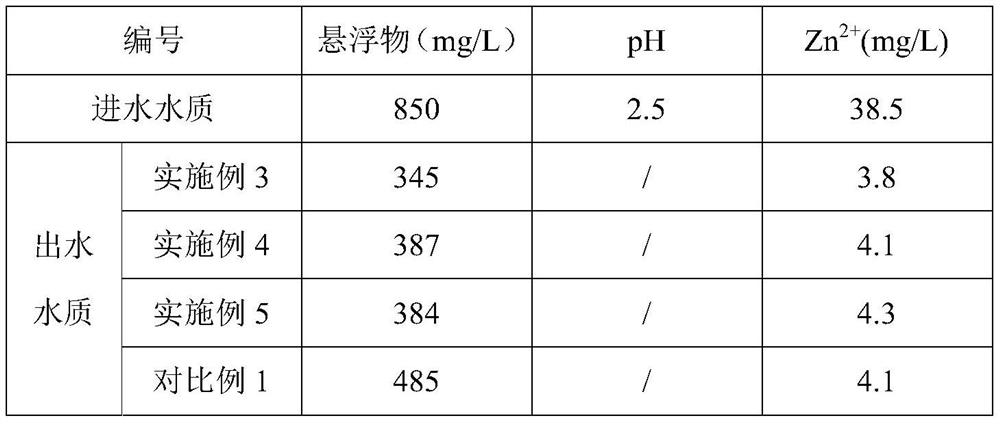Treatment method of viscose zinc-containing wastewater
A treatment method and wastewater technology, applied in water/sewage treatment, neutralized water/sewage treatment, multi-stage water/sewage treatment, etc., can solve problems such as difficulty in filtering viscose zinc-containing wastewater and treatment of zinc-containing sludge
- Summary
- Abstract
- Description
- Claims
- Application Information
AI Technical Summary
Problems solved by technology
Method used
Image
Examples
Embodiment 1
[0024] The present embodiment provides a kind of preparation method of chitosan modified low-density hollow glass microspheres, comprising the following steps:
[0025] 1) preparation of chitosan acidic solution: adding chitosan to an aqueous solution of acetic acid with a mass concentration of 2% for dissolving to prepare a chitosan acidic solution with a mass concentration of chitosan of 3%, for subsequent use;
[0026] 2) Pickling pretreatment of glass microspheres: choose a density of 0.3g / cm 3 Low-density hollow glass microspheres were used as raw materials, soaked in 3% hydrochloric acid for 25 minutes, filtered, washed with water until the filtrate was neutral, and baked at 90°C for 2 days;
[0027] 3) Surface treatment of glass microspheres: add phenyltriethoxysilane to absolute ethanol, stir and mix evenly to prepare a silane coupling agent treatment solution with a mass concentration of 2.5% phenyltriethoxysilane, and pickle pretreatment Add the above-mentioned sila...
Embodiment 2
[0030] The present embodiment provides a kind of preparation method of chitosan modified low-density hollow glass microspheres, comprising the following steps:
[0031] 1) preparation of chitosan acidic solution: adding chitosan to an aqueous solution of acetic acid with a mass concentration of 3% for dissolving to prepare a chitosan acidic solution with a mass concentration of chitosan of 4%, for subsequent use;
[0032] 2) Pickling pretreatment of glass microspheres: choose a density of 0.4g / cm 3 Low-density hollow glass microspheres were used as raw materials, soaked in 3% hydrochloric acid for 20 minutes, filtered, washed with water until the filtrate was neutral, and baked at 80°C for 3 days;
[0033] 3) Surface treatment of glass microspheres: add phenyltriethoxysilane to absolute ethanol, stir and mix evenly to prepare a silane coupling agent treatment solution with a mass concentration of 3% phenyltriethoxysilane, and pickle pretreatment Add the above-mentioned silane...
Embodiment 3
[0036] A treatment method for viscose zinc-containing wastewater, comprising the following steps:
[0037] 1) Pretreatment: Viscose zinc-containing wastewater is pretreated by aeration and filtration to remove most of the sulfide and viscose fibers in the wastewater to treat the wastewater together;
[0038]2) Floating adsorption: After adjusting the pH of a treatment waste water to be 6.5 with a sodium hydroxide solution with a mass concentration of 40%, add the chitosan-modified low-density hollow glass microspheres prepared by the method of Example 1 to the waste water for adsorption, Among them, chitosan-modified low-density hollow glass microspheres are added according to the amount of 6g / L wastewater, slowly stirred and mixed, and then left to stand for 2.5 hours to remove the upper layer of floating matter to obtain secondary treated wastewater;
[0039] 3) Precipitation: Secondary wastewater treatment uses sodium hydroxide solution with a mass concentration of 40% to a...
PUM
| Property | Measurement | Unit |
|---|---|---|
| density | aaaaa | aaaaa |
Abstract
Description
Claims
Application Information
 Login to View More
Login to View More - R&D
- Intellectual Property
- Life Sciences
- Materials
- Tech Scout
- Unparalleled Data Quality
- Higher Quality Content
- 60% Fewer Hallucinations
Browse by: Latest US Patents, China's latest patents, Technical Efficacy Thesaurus, Application Domain, Technology Topic, Popular Technical Reports.
© 2025 PatSnap. All rights reserved.Legal|Privacy policy|Modern Slavery Act Transparency Statement|Sitemap|About US| Contact US: help@patsnap.com

